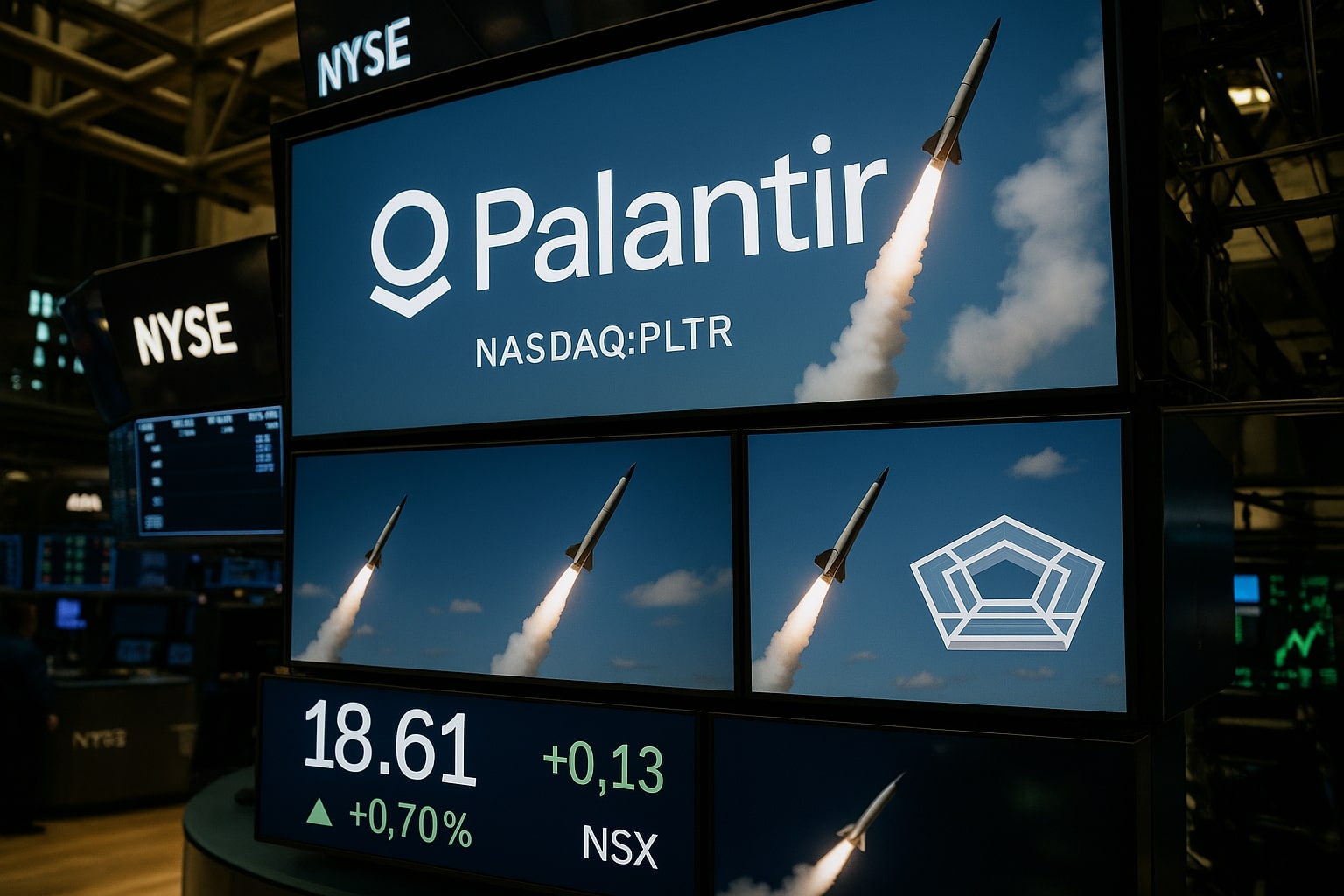Palantir (NASDAQ:PLTR) Emerges as the AI Core of U.S. Defense Tech
Golden Dome Integration: Palantir’s Unofficial Defense IPO
Palantir Technologies Inc. (NASDAQ:PLTR) is not pitching software anymore. It’s pitching a future. That future is now tied to Golden Dome—a proposed $175 billion U.S. missile defense system powered by artificial intelligence. Palantir’s role? Not a contractor, not a supplier—an indispensable AI brain. While Lockheed Martin focuses on hardware integration, Palantir is shaping up to be the digital twin engine, sensor fusion layer, and AI simulation environment that connects data from satellites, drones, and land-based systems. This isn't speculation—it's execution. And it’s happening now.
With SpaceX building a satellite web of over 1,000 orbital trackers and Anduril loading the system with autonomous interceptors, Palantir’s software turns noise into decision—tracking, filtering, classifying, and reacting in real time. Their platforms, including Gotham, Foundry, and Apollo, aren’t just watching—they’re simulating entire warzones in seconds. That’s not government work. That’s Silicon Valley speed injected into the most sensitive geopolitical domain: missile defense.
Palantir isn’t just providing AI—it's moving the Pentagon from hardware procurement to subscription-based warfare. If the Department of Defense moves to a SaaS-style deal with Palantir as the core digital layer, we’re talking recurring, high-margin, billion-dollar contracts. It’s CRM for missile command.
Revenue Impact: How Big Can This Be for PLTR?
Golden Dome’s initial Congressional ask is $25 billion, but internal defense sources suggest the long-term budget could stretch to $175 billion if passed. If Palantir captures just 2% of that, you’re looking at $3.5 billion—nearly doubling its 2025 revenue base forecast of $3.9 billion. That’s excluding additional NATO or Asia-Pacific alliances replicating the system.
This is not a one-off contract—Palantir’s role is foundational. Just like AWS powers the internet quietly in the background, PLTR could quietly power military decisions globally. And its GAAP operating margin of 20% already confirms a profitable scaling model. Investors should understand: once a defense software stack becomes operational, switching it out becomes a national security risk. Lock-in is not just probable—it’s strategic.
Margins, Model, and Military Scale
Palantir’s long-time critics have pointed to its government dependency as a risk. That narrative is shifting. The Golden Dome project flips the model. This is not standard procurement—it’s software-as-a-service. Unlike cost-heavy legacy contracts, PLTR’s model scales without matching headcount or hardware.
Once the platform is deployed, cost of revenue barely moves. Every new ally, every NATO-linked agreement, every extended satellite deal adds dollars without devouring resources. That’s why Palantir’s 2025 guidance of +36% revenue growth is believable—even conservative. Combine this with their proven execution on the $1.3 billion Army Maven AI contract, and you get a company built for government scale with startup speed.
Valuation Tension: Hope vs. Execution
Let’s be clear: PLTR’s valuation is rich. With a TTM P/E over 500, it has no room for error. But here’s what changes that math—flawless performance and repeatable wins.
The Street is watching whether Palantir can deliver a functioning satellite AI command layer by 2026, manage latency, ensure 24/7 reliability, and avoid security hiccups. If it does, the company won't be valued like a tech growth stock—it will be priced like critical infrastructure. The bear case? Delays, cost overruns, or failed satellite integration could quickly cut multiples in half. But even the bear case sees Palantir as a recurring contractor with guaranteed government cash flow. That’s not a disaster—it’s stability.
Sentiment Drivers: Watch Congress, Not Earnings
Palantir’s next 12 months won’t be moved by quarterly reports. They’ll be moved by legislation. If Congress approves the full $25 billion bill this year, PLTR will fly. If not, expect delays to hammer the stock. But every Pentagon whisper, every defense budget tweet, every leak of progress on integration will become price action.
And don’t ignore macro AI sentiment. While Big Tech scrambles for AI monetization, Palantir is shipping real-world AI systems with national security implications. The hype cycle may cool, but defense AI is insulated—budgets don’t swing with VC trends.
Insider Transactions: Confidence or Caution?
For transparency, PLTR insider activity has shown modest sales in recent months, mostly by early employees and executives exercising options. There’s no red flag pattern of dumping. In fact, CEO Alex Karp remains one of the most aligned executives on Wall Street, holding a substantial stake without regular liquidation. The leadership team's long-term incentive structure rewards operational success, not short-term stock pops.
Strategic Role vs. Lockheed: Not a Competitor, a Layer
A common mistake among analysts is comparing Palantir to Lockheed Martin (NYSE:LMT). They’re not competing—they’re collaborating. LMT is the weapon integrator. PLTR is the command intelligence. Think of Lockheed as the missile. Palantir is the brain that fires it.
They’ve already worked together on AEGIS combat system software deployment. PLTR’s Apollo platform is live in defense environments, updating AI layers autonomously with zero downtime. That’s the future of modern war logistics—and Palantir owns it.
Global Expansion and Commercial Leverage
While Golden Dome headlines the narrative, Palantir’s commercial customer growth is quietly accelerating. Fortune 500 clients using Foundry for logistics, supply chain, and risk analysis are now 40% of revenue. That means if government contracts hiccup, PLTR has a corporate lifeline. It also proves the tech isn’t just good—it’s adaptable.
International expansion, particularly in Asia-Pacific and NATO-aligned Europe, will be a major test. Watch for joint defense funding efforts in Japan, South Korea, and the EU. If PLTR secures a foothold, the Golden Dome model could be licensed globally.
PLTR Forecast and Verdict
Price today: $22.47
2025 revenue forecast: $3.9 billion
Bull case: $3.5B+ in Golden Dome SaaS + commercial growth = $7–8B revenue by 2027
Bear case: $3.5B flat, margin pressure, delayed contracts, stock back to $12
Base case: Execute on defense, expand commercial = $5B+ in revenue, stock stabilizes near $35–40
Conclusion: Buy Palantir Technologies Stock (NASDAQ: PLTR)
Palantir (NASDAQ:PLTR) is not just a stock. It’s an asymmetrical play on AI and defense convergence. If it executes on even half of the Golden Dome vision and sustains its commercial momentum, PLTR could be the first software firm to become a global security utility. Volatility is guaranteed, but this is the rare AI story with real contracts, real use cases, and global implications. The long-term risk-reward is skewed toward significant upside.
Let me know if you want a companion Prime Professional chart for PLTR.



















